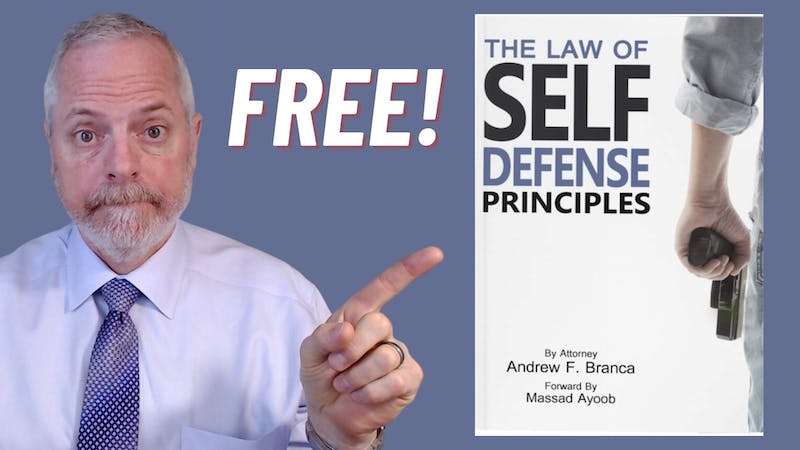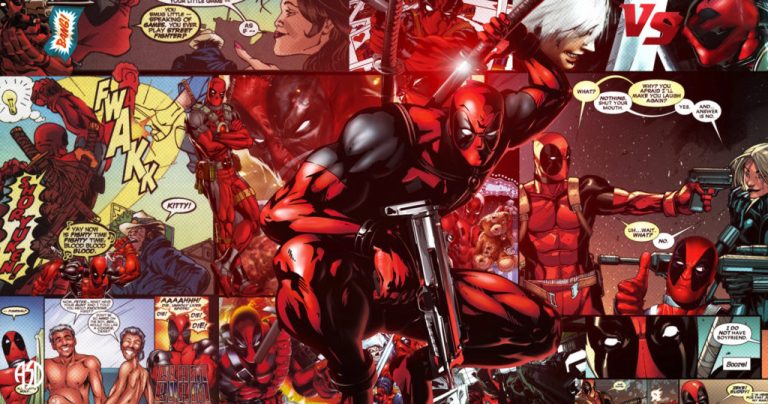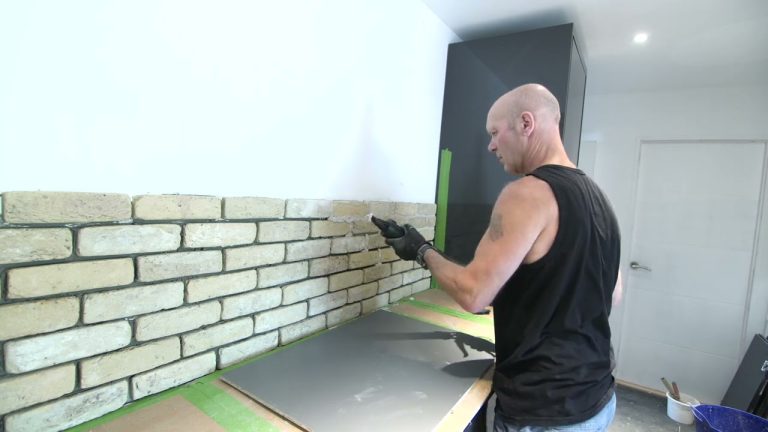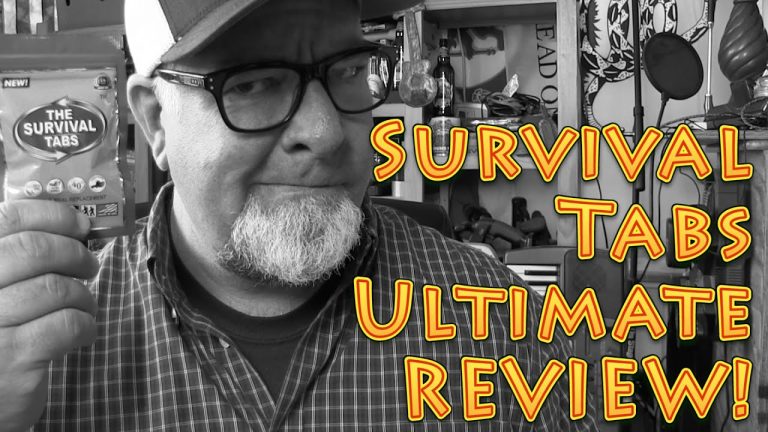You’re ambushed by a deadly criminal predator–fortunately, you manage to instantly inflict a mortal injury on him.
Can you continue to use deadly defensive force even though you’ve effectively already killed your attacker?
Today’s show addresses this important questions–and does so in a way that also documents your knowledge so that it can be shared with a jury if you’re ever criminally charged in this kind of scenario.
In today’s show we both explain the importance of documenting your specialized knowledge to ensure that you are hard to convict if ever compelled to defend yourself and your family (in the public portion of the show), and we also share a very blood video of a gunfight in a bank that precisely illustrates and documents today’s question (in the members-only portion of today’s show.
[TRANSCRIPT BELOW]
Resources:
Source video:
Learn How to be HARD TO CONVICT If Compelled to Defend Yourself, Your Family!
Grab your own soft-cover copy of our best-selling guide to self-defense law for FREE!
“The Law of Self Defense: Principles” is our best-selling, plain-English book that explains your legal privilege to use even deadly force in defense of yourself, your family, and others!
DON’T WAIT until the ATTACK HAPPENS–by then it will be TOO LATE!
Get your copy for FREE (except for S&H) by clicking the image or link below RIGHT NOW!
Disclaimer – Content is for educational & entertainment purposes only, and does not constitute legal advice.
Copyright Disclaimer Under Section 107 of the Copyright Act 1976, allowance is made for “fair use” for purposes such as criticism, comment, news reporting, teaching, scholarship, and research. Fair use is a use permitted by copyright statute that might otherwise be infringing. Non-profit, educational or personal use tips the balance in favor of fair use.
Transcript
(PDF Link)
NOTE: All LOSD video/podcast transcripts are prepared in rough form, provided solely for our members’ convenience & documentation, and are not thoroughly reviewed for accuracy. Refer to the original video/podcast for the authoritative form of this content.
BEGIN
Welcome everybody to today’s episode of the law of self defense. I am of course, attorney Andrew Branca for the law of self defense. Thank you very much. And today we have a kind of bifurcated show. So the first half of today’s show will be public and streaming over YouTube and Twitter and rumble. As is our normal practice.
And during the first half of the show, I want to talk with all of you about the importance of documenting your specialized knowledge of use of force law and use of force tactics. The second half of the show, I’m going to provide you with. A video illustration of this kind of specialized knowledge for the purpose of you documenting that knowledge in case it ever informs your decision making and self defense, but that video is extremely bloody.
And so that part of today’s show will not be. Publicly broadcast it’ll be streamed. We’ll cut off the youtube the twitter and the rumble streams and just continue with the law self defense members only stream. So that should be your expectations for today’s show. If you’re a law self defense member you should be over at the You remember dashboard and you’ll be enjoying the entirety of the show, both the discussion about the importance of documenting your specialized knowledge and the bloody video of the essentially a bank robbery that we’re going to be watching as a illustrative example of specialized knowledge that you need to document.
And we will today, if you’re not a law self defense member, you’ll only be seeing the. First half of today’s show. And there’s no, really no good reason for that at all because you can become a law self defense member for only 99 cents. Just 99 cents. Folks gets you a 2 week trial law, self defense membership.
The same access to our members only content as any other member for that two week period for just 99 cents. And if you stay a member after the two weeks and virtually everybody does, it’s still dirt cheap. It’s only about 30 cents a day, less than 10 a month to be a law self defense member. And then you get to enjoy the entirety of today’s show and all our other.
Law of self defense members only content. You can take advantage of that two week trial membership at law self defense. com slash trial. All right, folks, with that out of the way, let’s go ahead and launch the formal start of today’s show. Here we go.
All right. So first half of the show documenting your specialized knowledge. First, what is specialized knowledge was specialized. Knowledge is not common knowledge. We’re all presumed to possess common knowledge. We’re all presumed to know that fire is hot. Ice is cold. Knives are sharp. Things along those lines.
Things you just learn from normal life experience. Specialized knowledge is knowledge that you acquire through specialized education And training could be self taught could be in some kind of class could be this kind of content that you watch from law self defense things that the general public wouldn’t be expected to be knowledgeable about, but you’re knowledgeable about because of your specialized training and expertise.
Why this important distinction? A couple of reasons. One is that often this specialized knowledge informs your decision making in self defense in a way that would not be apparent to someone who lacks the specialized knowledge. So an example of this kind of specialized knowledge in a self defense context might be the tool or drill.
The tool or drill is an example of knowledge that helps us understand that an aggressor armed with a contact weapon can be a Lethal deadly force threat to us, even if they’re not standing immediately beside us, but they can be a deadly force threat at a distance that’s substantially greater than an untrained person might expect.
So you’re being threatened by somebody with a knife, for example, and they’re standing 10 feet away. Under 10 feet away with the knife, they, they can’t. extend their arm and reach you with the knife, right? They don’t have 10 foot long arms. So if you were to use deadly defensive force against that person, a prosecutor might argue, they have argued that your use of the deadly defensive force was premature because that person was not yet an imminent threat of deadly force harm to you.
And that’s the condition that is required before you’re justified in using deadly force and self defense. The prosecutor might pace off 10 feet from the jury box and turn back to the jurors, Maybe even hold up the knife, say, Ladies and gentlemen, at this distance with this little tiny night, am I a deadly force threat to you?
And of course, the prosecutors trying to suggest to the jurors minds that the answer should be no, that in fact, the person you defended yourself against at a distance of 10 ft armed with that same night in evidence. Was not yet a deadly force threat against you against which you were justified in using deadly defensive force, in which case it was not lawful self defense, in which case you’re just guilty of an unlawful killing convicted.
In fact, the tool or drill tells us that someone armed with a knife at 10 feet can readily be an eminent deadly force threat because the relevant tactical question is, can they bring that knife to bear against you? In a shorter period of time than you would require to defend yourself. If the answer to that is yes, then they are an eminent deadly force threat.
They’re within your defensive envelope. And the way Dennis Tuller did this, studied this, answered this question. He was a police officer in Salt Lake City. His he was a trainer for his department. His officers faced this dilemma all the time. At what point is someone with a contact weapon actually an eminent Deadly force threat against which we can use deadly defensive force.
And the way Dennis framed the question for police officers was how long does it take one of my guys typically to get his service pistol out of the service holster and score center mass hits on a target. And Dennis believed that time period was about one and a half seconds. So draw the pistol, get it on target, fire a couple of rounds center mass 1.
5 seconds. Then the relevant question from a distance perspective is how much distance can an aggressor armed with a contact weapon, like a knife, how much distance can they cross in 1. 5 seconds because if they’re inside that distance then they can bring the weapon to bear against the officer before the officer can defend himself if they’re outside that distance, arguably.
They’re not yet in eminent deadly force threat because the officer still has the ability to defend himself before they could bring the knife to bear. And when that, when Dennis studied this with many students, he had them run a certain distance in a second and a half. Turns out that typically that distance is 21 feet, 7 yards.
And that became known as the Tuller distance. The exercise being the Tuller drill and the distance being the Tuller distance. Meaning theoretically, hypothetically someone within 21 feet. With the contact weapon is an imminent threat with that weapon. They can close the distance to you before you can defend yourself.
Someone further than 21 feet is not yet. Now, of course, this is all very mathematical and the real world is much more complicated than this. So 21 foot’s not a magic number. It’s simply providing context that someone armed with a contact weapon can be an imminent deadly force threat, even if they’re substantially further than you might expect.
Much further than 10 ft, for example, it could be 15 ft away, still be an imminent deadly force threat. It’s all a question of how quickly they can close the distance. Say you’re in that courtroom and you have that prosecutor who paces off 10 ft from the jury box, holds up the knife, asks the jury whether or not he’s presenting as a deadly force threat to them.
And they think in their heads no, he’s too far away. He’s reaching out with his arm with the knife and he can’t reach them. That’s a dangerous jury for you. If you defended yourself with the knowledge of the tool or drill in your mind, you’re taking a defensive training class. They taught you the tool or drill you’re faced in the real world.
Suddenly with a, an aggressor with a knife, he’s 10 feet away. That’s well within the tool or distance of 21 feet. You use deadly defensive force to defend yourself. And now the prosecutor is suggesting to the jury that your use of deadly defensive force was obviously unlawful because the aggressor with the knife was a whole 10 feet away.
That’s not the relevant tactical or legal question. And you’d like the jury to be informed about that as well. So you’d like to be able to explain to the jury, either in your own testimony or more likely in the form of a use of force expert witness hired by your defense, you’d like to have explained to the jury this whole concept of the tool or drill.
And that 10 ft is not too far away. 10 ft, in fact, is well within the tool or distance. But this knowledge of the chuler drill is specialized knowledge. It’s not something the jury would know by default. It’s not common knowledge. It’s specialized knowledge. So because the jury won’t know it when they’re chosen for jury duty, you need to educate them on this specialized knowledge.
And you are allowed to educate the jury on specialized knowledge. If you can document to the court. That you possessed that specialized knowledge at the moment you acted in self defense, because if you did possess that knowledge, then arguably it informed your decision making and self defense reasonable enough.
But what have you only learned about the tool of drill? Afterwards, you defend yourself against this guy with the knife, knowing nothing about the tool of drill, never heard of it. You just shot him because it seemed like the right thing to do. Not because it was informed about any knowledge of the tool or drill, because you didn’t have any knowledge of the tool or drill.
And then after The act of self defense while you’re waiting these pending trial, you’re reading through some self defense books or something and. Oh, wow. You learned about the tool or drill then. And you’re like, yeah, see, I did make the right decision. Now that I’ve learned about the tool or drill, here’s the problem.
Learning about the tool or drill after the fact could not have informed your decision making in the moment. And if it couldn’t have informed your decision making in the moment, it was not part of your subjective state of mind. And therefore it’s not admissible as evidence. Now you might. Ask your attorney to argue to the court.
Your honor he did know this at the time and therefore it should be admissible. It did inform his decision making. The jury should therefore learn about this and the prosecution is going to say where’s the evidence that he knew it at the time that he didn’t just learn of it afterwards because in the absence of evidence that you knew it at the time, then we know you’re just making it up.
There needs to be something, some more than zero, not a lot, but more than zero evidence that you possess knowledge of this tool or drill at the time you acted in self defense. And how might you do that? You might have taken a defensive class. You might have read a book. You might have watched this show, this law of self defense show.
And maybe any of those ways you might have acquired knowledge of the tool of drill before the moment you had to defend yourself against the criminal predator. But how do you document that? We talk about the tool of drilling our stuff, our books. And I always encourage people read our book like it was a textbook.
It doesn’t read like a textbook. It’s all written in plain English. But make notes, highlight things, underline things, make notes in the margins, put dates in the margins. When you read interesting things that you think you may use this information to inform your decision making and self defense. And then your lawyer could bring this book in your book, your annotated book, your hand annotated book as evidence of You having acquired this knowledge before the moment you had to act in self defense, you may have taken a course and the course came with a syllabus and a certificate with a date on it.
We provide certificates with dates for all our courses. That’s document thing that you possess, whatever knowledge was in that course. Or if you’re a law self defense member, one of the things we do for our members is we provide documentation of every show we do. So for example, here’s our show from yesterday where we talked about the street performer statue.
So perhaps you watched yesterday’s show with us after the live stream of the show, which is normally the initial way that we share our content. We of course take the recording of the live stream and we make it as a playback for our law self defense members. This is the law self defense blog. We have thousands of blog posts and videos there largely locked down for our law of self defense members.
Now, you may be thinking I watched yesterday’s show on YouTube. What’s different about watching the playback on the law of self defense blog? If you’re a member, of course you get the same video. That we live stream the same one that’s still available on YouTube today, but you get more, you get additional resources that may have been relevant to yesterday’s show.
Like the original video file of the event we talked about. If there’s documents that are relevant, you get PDS to those documents, for example, which we don’t provide any of that in the public streams. Little promo for our book there. You can get the book for free at law self defense. com slash free book.
But another thing we do for members is we provide a transcript of every show on the blog post. So it’s in there in text form, as you can see here. And you’ll see it’s our shows are long, so the transcripts are long, but not only do you get that transcript, and this is only for law self defense members.
These are locked down blog posts. So you need to be a member to access this. Not only do you get the transcript right there embedded at the bottom of the blog post, but you also get the PDF. A downloadable PDF of the transcript of every show looks like this. So it’s nothing fancy. It’s just A-A-P-D-F version.
With the title of the show, the date of the show, the key is it’s downloadable for you members, so you download it to your computer. You keep it as a record, as documentation of your acquisition of this specialized knowledge and. That’s what makes it admissible in court, which is particularly important if it is if that specialized knowledge was why you acted in that particular way in self defense.
That’s why you fired that shot at 10 ft. Now, prosecutor is going to try to argue to a jury that 10 ft was unreasonable. You should have waited longer. Maybe the shot never had to be fired. Maybe if you’d waited another 2 ft. The aggressor would have changed his mind and just gone home and nobody would have had to have died that day.
So you jumped the gun, so to speak. You need to counter that argument because that is why you shot the guy. That is the tool or drill knowledge is what makes your use of force reasonable. And if the jury doesn’t have that context, they may well conclude it’s unreasonable and off the person you go. We don’t want that.
We want you to be hard to convict, not easy to convict. And this kind of documentation can be absolutely critical. In your ability to persuade the jury by having that use of force expert witness talking about the tool of drill or whatever other specialized knowledge informed your decision making and self defense so they can see it was reasonable and therefore lawful self defense.
And that’s an acquittal folks, by the way, you think the prosecutor knows when he’s thinking about prosecuting you in the first place, whether or not you’re likely to be able to document the foundational basis for your use of force and self defense. And that you think the prosecutor knows that you’re much more vulnerable to effective prosecution.
You’re much easier to convict if you can’t document your specialized knowledge that informed your decision making and self defense. Yeah, they know that. You think that if your defense counsel can show the prosecution all this massive amount of documentation of your specialized knowledge, all of which the jury can be instructed on by an expert witness on the defense behalf, you think the prosecution realizes, you know what this is going to be a hard to convict case.
Yeah, they will. And they don’t like to bring hard to convict cases to trial, folks. Most prosecutors have conviction rates of trial at 90%, 95%. And it’s not just because they’re, brilliant lawyers. Many of them are very good lawyers, but it’s because they get to choose which cases go to trial. So if your favorite sports team got to choose which opponents have played every Sunday, they’d have a 90 percent win rate too, right?
They just wouldn’t play the hard teams. So if you can present to a prosecutor as a hard to convict case, you’re much less likely to get prosecuted in the first place. You become an unattractive target for prosecution. And a big part of that is your ability to document the specialized knowledge you want presented to the jury in your defense.
So that’s what I wanted to share with all of you in the first half of today’s show. The importance of documenting your training. And of course it doesn’t have to be done only through law of self-defense, or even through law of self-defense. But whatever specialized knowledge you have, I would urge you to make sure you document it and keep that documentation in a safe location because you may need it someday.
And it could be the difference between. A conviction and an acquittal at law self defense. We try to make the documentation process as convenient and efficient and pain free for our members as possible. That’s one of the benefits of being a law of self defense member, which again, you can do for only 99 cents.
Folks get a two week trial membership for just 99 cents at law self defense. com slash trial. And after the two weeks, it’s still dirt cheap. It’s only 30 cents a day to be a law self defense member, less than 10 a month to get all our members only content and the benefits of these transcripts and everything else we do for our membership.
But at least you should try the two week trial for 99 cents folks. You can hardly lose there at law of self defense. com slash. All right now. We’re going to move on to the second half of today’s show. And this is the very bloody bank robbery video. This is it up here, but I’m not going to play it on the public streams because YouTube freaks out.
And in any case, this is an example of the kind of specialized knowledge that we provide in our members only content. So I hope all of you on YouTube and Twitter and Rumble learned a thing.
And then we’re going to move on to the, if you’re a law self defense member, don’t go anywhere. We’re continuing the show. But if you’re watching on YouTube, this is the end of the show for you. Have a good weekend.
And if you’re watching on X that’s not what I wanted to do. If you’re watching on X, this is also the end of the show for you. Have a good weekend folks.
And finally rumble.
And now we are streaming only to our law of self defense members. Great. That’s exactly how it was supposed to work. So a fair warning law self defense members. This is an extremely bloody video. Very bloody. I don’t want you to say I did not warn you. And we do watch a man die in this video. He had a coming, but nevertheless, he’s a human being who dies on the screen.
So fair warning if you don’t want to continue, but the lessons, there’s a number of lessons here. One is. Lessons you can learn that might inform your only your own decision making in a deadly for self defense encounter. One is how fast things happen, right? There’s not a lot of time for decision making a split seconds.
There is a little glitch in this video, but we’ll see it jumps from the 28 2nd mark to the 30 2nd mark. I don’t know what happens to 29. So at the very beginning, the bad guy goes from a chair to halfway to his intended victim. Like in a flash, it actually took him two seconds to do that. Two seconds in a fight is a long time.
A lot can happen. Like we know from the chuladro. Someone from a standing position could cross a second and a half, 21 feet in just a second and a half. Much less two seconds. This bad guy has to go from a seated position to close in proximity on the guard in the bank here in the lower right hand corner.
The bad guy’s wearing a hat in the far upper left. Of the image here, by the way, I think there’s, I think they’re both bad guys in those seats, but the guy in the hat is the problem. He’s the most active aggressor who will be mortally wounded in this video and the bank guard is there on the right.
So the guy in the hat is going to jump out of a seat and rush at the guard firing a, and the guards going to respond in kind. So very quickly from very peaceful looking situation like we have here in the screen to maximum violence in a very short period of time. And then the fight continues for a remarkable period of time.
And that’s the other thing I want to encourage you to learn from this is it appears that almost instantly,
it appears that almost instantly it looks like the first shot fired by the guard in self defense. I can’t believe I’m still not over this cold. Hold on one second.
No, it’s gross. Sorry. All right. It seems that almost instantly, this guard, probably with his first shot, scores a fatal hit on the bank robber. The round appears to strike the carotid artery in the bank robber’s neck. And as happens when a major artery in the body is breached, the blood comes out like a fire hose.
I’ve worked on murder cases. Where the the one I’m thinking of in particular, a young woman was at a one night stand with a guy who then attacked her in the morning and she had a tiny little, like a little spider cone knife and she managed to stab him once in the chest with it and hit the aorta and the blood came out of that dude.
Like a fire hose in this room, it was everywhere, ceilings, walls, down the stairs, just, and we’ll see much the same effect here. The bad guy’s mortally wounded. There’s no saving him from that kind of injury. Yet, he continues to fight, effectively, aggressively, against this bank guard, even though he’s been mortally wounded.
A bad guy can be mortally wounded. And still be capable of killing you for many seconds thereafter, maybe a minute, maybe two minutes for quite some time before they finally succumb to the mortal injury. So the mere fact that you’ve inflicted a mortal injury on your aggressor doesn’t mean the fight’s over if they’re still capable of killing you, maiming you or doing that to other innocent people, which touches upon the related.
Legal doctrine being that how long are you allowed to continue to use defensive force against an aggressor? As long as you continue to face an eminent, deadly force threat from that aggressor. And that can be true, even though you’ve already mortally wounded them. So you can continue to use force so long as you continue to face the threat.
And that might require you to continue defending yourself for a few more seconds or for another minute or for two minutes, it may. It may require you to fire an additional round or four rounds or 10 rounds or 20 rounds. Whatever is needed to defend yourself. So long as you continue to be facing an imminent deadly force threat from that aggressor.
Now, the moment you’re no longer facing an imminent deadly force threat they fall over unconscious. The gun bounces away. If you walk over them and shoot him again, that’s probably just an execution shot and not legally justified. The window of eminence is closed by that point, but as long as they continue to present as a threat, you’re legally privileged to continue to use.
Force in self defense. So those are some of the lessons here. And the reason I want to share those with you. And the reason I want you to document them is you may find yourself in a circumstance where you’re defending yourself in a fight that goes on a lot longer than one would like out of necessity, because you continue to face that deadly force threat.
So you have to continue to be fighting in your own defense or defensive others. But it’s the kind of scenario, like we talked about in the first half of the show, where a prosecutor might try to persuade a jury that, in fact, you used too much force or you used force too long. It was no longer necessary.
You’d already mortally wounded this poor kid. If the person you’re defending yourself, say, was 17 years old, the prosecutor will portray them. They could be 200 pounds and 6 feet tall, but the prosecutor will portray them as a child. You’d already mortally wounded this child and you continued to spray bullets around that room.
Does that have to be true for the prosecutor to say that? Nope. They’re allowed to tell their narrative of guilt to the jury. But you need to be able to counter that. Why did you continue shooting even though you saw all this blood come out of their neck? Because you know from watching videos like this one.
That someone can have that kind of injury be spraying blood everywhere and still be capable of lethal offensive force as we’ll see. This bad guy was now the guard here does end up getting shot. I believe he survives that gunshot. The bad guy obviously does not survive. So let’s expand the video here so we can get a better look and I’ll go ahead and play it last caution folks.
Very bloody video. It’s particularly obvious because the floor is all white and the blood, of course, is very red. But again, the main lesson here is how quickly the fight sets off, how quickly the guard defends himself with decisive force. Really? That’s a fatal injury with the first round. It’s pretty good.
I see an essay. It would have been better, but under this kind of time constraint and how. Effectively, the bad guy continues to operate against the guard despite having been mortally wounded and how effectively and how long before finally he loses enough blood pressure that the, the brain just shuts down with those cautions out of the way.
Here is that video. Let’s go.
That’s the guy’s painting figures on the floor with his arterial blood flow
and he’s getting dizzy and goes to sleep still moving. And finally he lays down. And takes the forever nap. All right, let me rewind this. That’s all 40 seconds, folks, is the duration of the video. So we start here at the beginning. Whoops.
Timestamp zero bad guys there in the hat, the guy who will be doing the shooting, who will bleed out. He’s there in the hats. For some reason the first second is missing. So he just magically appears right there. But that’s about a second. So he gets out of his chair, gets his gun out on the guard, muzzle on the guard, two hands on the gun, by the way, which is a suggest some kind of training, disciplined handling of the firearm.
Especially here at this distance. It’s still, under stress running two hands on the gun is generally a good idea. Bank guard is still doing nothing, right? He’s just. Looking over now and seeing that, holy cow, there’s a lunatic coming at me with a gun, probably firing already. So this is the second, number two, second,
still the second, that’s the first second sorry, the end of the second is right about here. Look how close the bad guy is, and now the cop has his gun up and this is where he fires, I believe, the first shot, looks like he’s got a revolver, fires the first shot, that strikes the bad guy’s neck.
Cop has two hands on the gun, too. Aimed fire. They both have the guns up in line of sight. This is a dangerous bad guy. If he knows how to run a gun and it certainly looks like he does dangerous bad guy. Fortunately, it looks like the cop, the guard also knows how to run the gun flinching.
They’re both flinching away from each other’s shots and the bad guy. There’s a little bit of smoke right there. So I think that’s a shot from the guard and, but the bad guy is still up, still has two hands on the gun that comes off. Maybe another shot there. By the guard, he still got his gun up.
You’ve seen the bottom of the screen. I think this figure on the left is a second bad guy who begins to run once he sees that his his buddy has been mortally wounded. And right away. Suddenly, if you look. At the floor by the bad guy’s leg. You’ll see spots appear on the white, right? He’s bleeding already.
This is 2nd. This is the 3rd 2nd into the fight and the bad guy has been mortally wounded.
Still got 2 hands on the gun arterial blood spray coming out of them all over the floor and he’s still in the fight. He’s looking the guard has ducked down behind these counters here. Bad guy’s bringing the gun up, two hands, line of sight, aimed fire, he’s looking, he’s hunting for that guard, hunting for him, even though, there’s the guard’s pistol on the bottom there, he’s hunting for the guard’s trying to get away, get some cover, looks like he trips over something, that’s his foot there, he’s diving, maybe, the bad guy, still shooting, still has his gun up on the target, he’s gonna reach over the counter here, he’s gonna shoot the guard, again, Look at all that blood on top of that counter coming out of this bad guy, and he is still in the fight, tracking that guard all the way behind the counter.
Now he’s only shooting with one hand because he’s clamping his other hand on his carotid trying to, what else are you going to do? I suppose it doesn’t help. There’s just, there’s way too much blood pressure. There’s other people in the back. Bad guy still up, still shooting, still got his gun up line of sight, still perfectly functional.
I shouldn’t say perfectly functional, but capable in this gunfight guards going out the door there, leaving some other bank employees behind. And the bad guy decides you know what? Maybe I should just try to get away. It goes in the, so the fight here is the bad guy gives up. Basically he’s not stopped.
He basically decides all right, this isn’t working out. I’m going to leave. This is 18 seconds in. So he was, we saw he was mortally wounded at three seconds in. So for another 15 seconds, He’s still aggressively in this fight. How many rounds can the bad guy fire in 15 seconds? In theory, about five rounds a second, right?
Of course he’d run out of rounds before then, but there’s a lot that can happen. In 15 seconds. Same with the guard. Of course, if you know how to run the gun, you can get two tenths of a second splits pretty easily. That guy decides to leave blood, spraying the interior of that revolving door blood, trying to get out.
He’s getting starting to get dizzy here, starting to lose blood pressure. More bank employees. These look like women. There’s the guard maybe coming back
and again, the guard was shot too, but I believe he survived his gunshot that guy. Just that’s it lays down. Yeah. I think this blood here. If we, I need to move my the figure of my head. If you look at the bottom left corner here, you’ll see blood spatter here. I don’t believe that’s from the robber.
I believe that’s from the guard. When the robber reached over the counter and shot the guard and the bad guy finally right there looks like he just goes out completely slack and he’s lost all blood pressure. And that’s the end for him. All right, folks. So those are, that’s the video I wanted to share with all of you.
The lesson I wanted to share with all of you in today’s show to document. The various dynamics we talked about how fast the fight happens how lethal even one round can be. So you can’t risk getting shot even once folks, because it could be to the carotid how someone can be shot in the carotid and still be effective in the fight.
By the way, this applies to you too. You may find yourself in a scenario where you’re with your family, you’re attacked, you’re compelled to defend yourself. You might suffer a mortal injury right there. First shot. Does that mean you’re out of the fight? Does that mean you can no longer defend your family?
It rather depends on you. Doesn’t it? You’re not necessarily out of the fight. You may already not make it. It may be over for you in the long term, but you may have another 15 seconds to solve that problem for your family’s benefit, say a home invasion scenario. So don’t give up. Just because you’ve been mortally wounded, you can keep going, and the bad guy might keep going too.
So don’t assume just because you got a solid hit on the bad guy that the fight’s over. By the way, typically when you shoot somebody with a gun, and when you, I shouldn’t personalize it, when somebody’s shot with a handgun, can you typically tell whether they’ve been hit? Immediately. Do they just stop what they’re doing?
Could you have had misses or not very effective hits or really effective hits? But, you may have mortally wounded them, but they’re still fighting for another 5, 10, 15 seconds. All of those could be true. You could have missed entirely. You could have fired 34 rounds and every one of them missed.
Do you stop fighting? Is the number of rounds you’ve already fired, is that what determines whether or not you continue to use defensive force? This is, this, at least back in my day, was common training. Fire twice and then reassess. Fire twice and reassess. Bam, reassess. But what if you fired bam and they were both misses?
You hope they’re not, but trained police officers miss 30, 40 percent of the shots they fire in fights. Could happen to you too. You fire two shots and they’re misses and you pause to reassess and the guy kills you. That wasn’t a good plan. So what determines whether or not you continue using force is not what you’ve done.
It’s your observations of the apparent threat you’re defending yourself against. Are they still in the fight? Is that bad guy still presenting as an imminent deadly force threat? If he is, that’s what determines whether or not you continue to use defensive force. Not the number of shots you’ve already fired or whether or not you think you’ve hit him or whether or not you know you’ve hit him.
Again, this guy is pretty obvious he was hit. Mortally, right? Hard to hide blood everywhere. Still in the fight. Okay, folks, that’s all I have for everybody today. Today’s Friday. I will say that this year, as I did last year, I will be teaching next weekend. At Harry trainers, Mickey Shooks, a self defense instructor carry trainers, his company.
Once a year, they do a multi day training event out in the Nashville area. They call it S 12. It’s probably sold out, but if you Google carry trainer S 12 you’ll see a video from prior events and maybe you can still grab a seat there. It’s a great event. I was there last year. Three, four days. I think it is.
And of course I taught there when I was there last year, I’ll be teaching there again this year. And I’m really going to be so I’ll be traveling out there. So next week’s content will be a probably travel content not necessarily prerecorded. I think I’ll do live streams, but it’ll be like live streams from hotels and the timing, the schedule of the show will be dictated by travel demands.
So it probably won’t be noon eastern time every day. And that will be true for next week. And then the following week is as I travel back as well. So just a heads up on that. If you can come to as well, I strongly encourage you to do that. It’s certainly it’s the best multi day training I’ve ever done.
And I’ve done a lot of fancy multi day training. I’ve been very fortunate in that respect. But if you go carry trainer, just Google carry trainer as 12, there’s lots of video from a prior years events. You’ll see how dramatic and high quality it is. All right. Anything else? I don’t think so. So today’s Friday.
There won’t be any shows this weekend. And so have a safe and happy weekend. Remember if you carry a gun, so you’re hard to kill, carry a knife. So you’re hard to kill, carry pepper spray. So you’re hard to kill. Study BJJ. So you’re hard to kill. I do all those things. So I’m hard to kill. So my family is hard to kill.
If you do some or all of those things. So you’re hard to kill. Your family is hard to kill. You also owe it to yourself and your family to make sure you know the law. So you’re hard to convict as well. Until next time, I remain attorney Andrew Branca for law self defense. They say you.


















